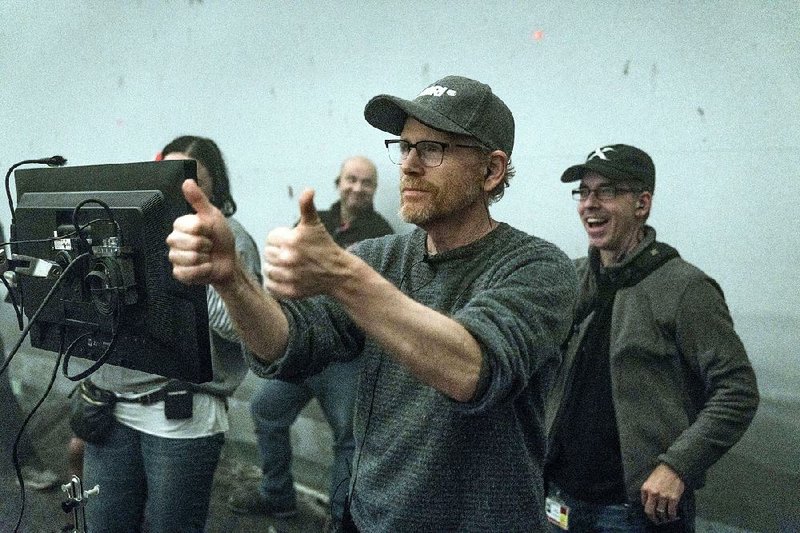Some people call him the Space Cowboy. But he is not yet the Gangster of Love. No, the Han Solo we meet in Solo: A Star Wars Story -- a prequel, opening today, to the Star Wars movies that featured Harrison Ford as the intergalactic rogue -- is a young man pining for his first love. And before he can get back to her, if he can get back to her, well, as in any Western whether set in Arizona or Alpha Centauri, a man's gotta do what a man's gotta do.
"There are certainly elements that feel Western and carry that flavor. Definitely there's a frontier vibe," agrees director Ron Howard, who had ridden in like the cavalry when the original directing team of Phil Lord and Christopher Miller was replaced six months into the production. "So that ethos certainly influenced the movie," the 64-year-old Oscar-winner says. But, he amends, "I'd say it's more of a late '60s, early '70s crime-action movie like Bullitt and Dirty Harry, where the lead characters have a Western feel, but instead of horses and wagons, it's muscle cars."
Or, in the case of Solo, Landspeeders and Swoop Bikes -- the latter used for galloping horses in an Old West attack against Han Solo (Alden Ehrenreich), his outlaw mentor Beckett (Woody Harrelson), his furry alien buddy Chewbacca (Joonas Suotamo) and others as they essentially try to rob a train. Campfires, saloon card games and even a climactic showdown inform this story of a young Han losing and perhaps regaining his love Qi'ra (Emilia Clarke), finding allies such as Lando Calrissian (Donald Glover) and righteous robot L3-37 (voice of Phoebe Waller-Bridge), and robbing a mining planet at one end of the fabled hyperspace route the Kessel Run at the behest of a ruthless robber baron (Paul Bettany).
"When I came in, they'd been shooting for quite a long time," Howard says of Lord and Miller (The Lego Movie, 21 Jump Street and its sequel), whom producer Kathleen Kennedy fired in June over what she called "different creative visions." "They'd done a lot, and Phil and Chris' fingerprints continue to be all over the movie in ways I really appreciate and value."
Howard continued with the overall look cinematographer Bradford Young was using, "and one of the movies they talked about" as inspiration, Howard says, "is one of my favorites, McCabe & Mrs. Miller," Robert Altman's 1971 revisionist Western about a Pacific Northwest town built on a mine and a brothel.
Solo embodies more traditional storytelling than Altman's, but there's just as much honest grime and mud. "I wanted the look to personalize it as much to the Han Solo journey as I possibly could," says the actor-turned-filmmaker, who earned Academy Awards as director and as a producer of 2001's best-picture winner A Beautiful Mind, and whose films include Cocoon (1985), Apollo 13 (1995) and The Da Vinci Code (2006). "This is not a war story, it's not an ensemble story -- it's this guy's journey, and I wanted the shooting style to reflect that."
Howard arrived just days after Lord and Miller departed, jumping in with a battle scene on the aforementioned mining planet, shot on the back lot at Pinewood Studios outside London. (The movie also filmed on location in the Canary Islands.) The rapid handover came through Howard's long association with Star Wars creator George Lucas, for whom he starred in the now-retired filmmaker's early hit American Graffiti (1973), and Lucasfilm's Kennedy, longtime producer for their mutual friend Steven Spielberg.
"It was a request, and frankly, I was reluctant," Howard recalls. "It was a regrettable situation, these creative differences that led to that, though I have to say Chris and Phil were very gracious with me and they have been through the whole process. That said, there was a lot of work to do. There were some new ideas that the creative team really wanted to try. There were scenes to be completed and things to work out."
His initial reluctance is understandable, given the number of projects at his and Brian Grazer's production company, Imagine Entertainment. In addition to producing such television as National Geographic Channel's Genius, Howard was attached to direct the novel adaptations The Girl Before and Seveneves, according to trade reports in 2015 and 2016, respectively.
"I had not planned to direct anything last year" after having directed two films released in 2016, Inferno and the documentary The Beatles: Eight Days a Week -- The Touring Years. "Normally it would be a two-year commitment to come in and do one of these movies. But given the opportunity to play in that sandbox, help out some friends, tell a story I really believed in and do it all in nine or 10 months, it was a little bit serendipity," Howard says.
And while he was a gun for hire, "Once I got into it, I fell in love with it," he says. "I feel as connected with it as with anything I've done."
What about the investors, production partners, studio distributors and others on those earlier projects who were put on hold? "Funny how it works," Howard says, marveling a little, "but when it's Star Wars, everybody kind of just nods and understands."
Because what'ya gonna do when a man's gotta do what a man's gotta do?
MovieStyle on 05/25/2018
